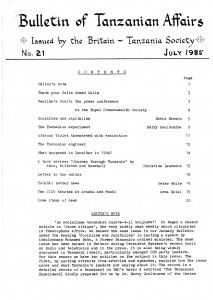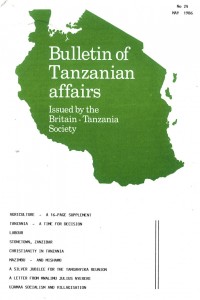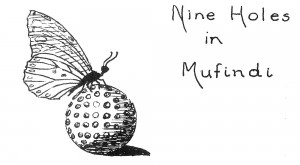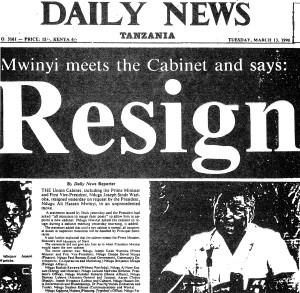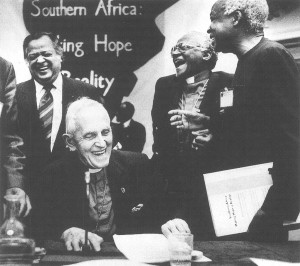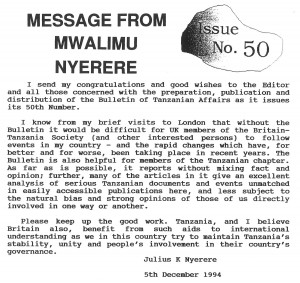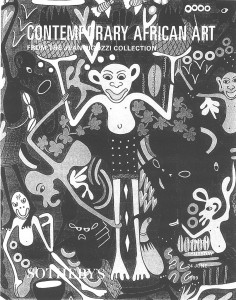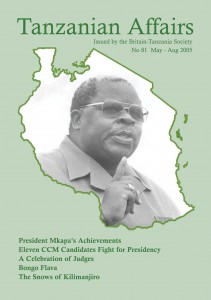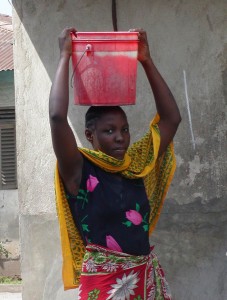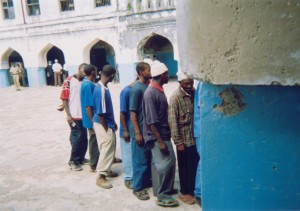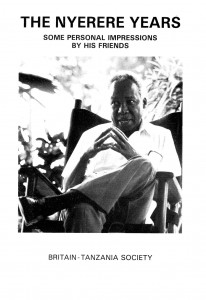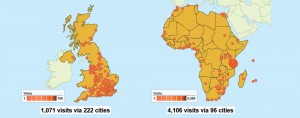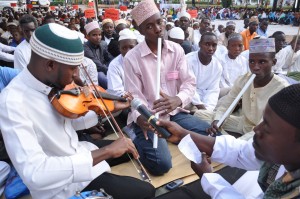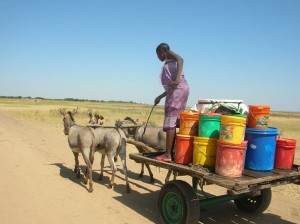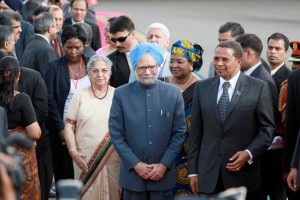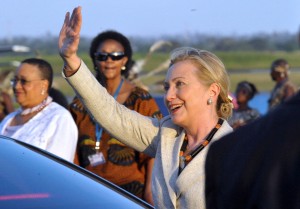The following contains brief notes on some of the more unusual and memorable stories to have featured in Tanzanian Affairs over the years, with apologies for the large number of articles which have been missed, and the inevitable personal bias in the selection. Please write in or comment online about any other articles that you particularly remember. Apart from the earliest issues (1 to 21) all the articles can be found online at www.tzaffairs.org
Jacob Knight
Issue 1 (Dec 1975) edited by Dr Terence Ranger is in A4 format with 12 pages, and brings news of the first passenger train leaving Kapiri Mposhi station in Zambia for Tanzania – the TAN-ZAM railway is born. TANU have published a booklet claiming that over 9 million people have been resettled in villages, but the Bulletin suggests that not everyone is happy, with widespread reports of resistance to villagisation.
Issue 4 (January 1977) announces the formation of the ‘Chama Cha Mapinduzi’ (Society of the Revolution) combining the two ruling parties – the Tanganyika African National Union (TANU) and the Zanzibar Afro-Shirazi Party.
The release from detention of Mr Abdulrahman Mohamed Babu and three others who had been condemned to death in Zanzibar, in absentia, for their alleged part in the assassination of the first President of Zanzibar, Sheikh Karume, is covered in Issue 6.
Issue 7 contains even more dramatic news – the Idi Amin regime in Uganda has invaded Tanzania in October 1978 and Tanzania is mobilising for war. The Bulletin has a new editor, Mr John Arnold, and it has grown to 18 pages.
Bulletin No 11 in December 1980 is a special issue devoted to the state of the Economy. Tanzania’s long period of negotiation with the IMF is under way.
Issue 15 covers the story of the hijacking of a Tanzanian aircraft and the subsequent arrest of the hijackers in Britain. A tragic sequel to this event is the death of Musa Membar after being held in administrative detention on his return to Tanzania (Issue 40).
Issue 19, now under the present editor, David Brewin, records the untimely death of Tanzania’s popular Prime Minister, Mr Edward Sokoine.
President Nyerere’s visit to the UK is covered in Issue 21 (July 1985), where in a “short but tough” interviewon BBC Newsnight with Peter Snow he was asked: “Is there not some way in which the system, particularly the agricultural system, the communal socialism which you introduced in Tanzania… has caused the failure of your country to produce what it should be producing?” The President replied: “What do you say to that ? African agriculture is backward in socialist and non-socialist countries alike. In my country we use the hand hoe. In capitalist countries in Africa they use the hand hoe. That defines the limits of what the peasant can do. The difference between a socialist country like Tanzania and a non-socialist country is that the burdens of poverty are shared better in a socialist country than they are in a non-socialist country.”
Issue 22 (Oct 1985) marks the change to the A5 booklet edition which we are all familiar with (cover designed by Richard Moon). It includes a special supplement “The Nyerere Years” to mark the end of his Presidency, containing essays on Nyerere from his friends including many members of the Britain-Tanzania Society – well worth a read.
Issue 24 gives weight to the economic problems facing the new President Mwinyi, but also highlights agriculture, with articles about peasant farming, the problems with transportation, and traditional knowledge on microclimate modifications (such as wind protection by scattered obstacles and trees/bushes). Randal Sadleir reviews a BBC documentary on the groundnut scheme – forty years on.
Issue 25 (1986) includes an item from the Daily Telegraph about the fate of a team of donkeys which had been used by a team of British explorers retracing the steps of Victorian explorer Stanley. After discussions involving Prince Philip, Prime Minister Mrs Thatcher, the RSPCA, and others, the Tanzanian Air Force is able to rescue them and fly them from the shores of Lake Tanganyika to Kenya where donors had provided funds to accommodate them in an animal retirement home near Nairobi. The issue also includes the first mention of the AIDS epidemic in Tanzanian Affairs noting that 125 cases of “Ukimwi” (the new Swahili word) have been reported with research workers estimating that 0.01% of inhabitants of Kagera are potential carriers.
As well as analysis of the economic recovery by Roger Carter, Issue 26 (1987) notes the sad accident during the visit of Mother Teresa to Hombolo, and covers the Kilombero sugar estate where three people were killed and many more injured by Field Force Units, called in after workers demonstrated over non-payment of overtime earnings. There is also a useful guide to the Parliament of the United Republic of Tanzania written by the speaker of the National Assembly, Chief Adam Sapi Mkwawa.
Reporting on an international conference under the heading ‘The Arusha Declaration 20 year after its Publication’ Professor Terence Ranger writes about the cheerful Christmas bustle of Arusha where for the first time in a while there are abundant goods in the shops. Many conference delegates felt that the crisis in agriculture arose because the Declaration was not effectively carried through; others felt that the Declaration was a flawed document; but everyone could agree that many of the problems stemmed from weak and corrupt party management.
An article on “Informatics Technology” in Issue 27 estimates there are currently 400 computers in Tanzania. There is also an article about Tanzanian Adam Salim and Kenyan Fadhili Williams who both claim to be the author of the legendary song “Malaika”. “A Queen’s Scarf” by Mr J.T.Purvis recalls how puzzlement over a grave inscription on a grave in Old Shinyanga led him to find out more about the “QS” decoration awarded to Major A.H Du Frayer QS OBE. Four scarves were knitted by Queen Victoria shortly before her death and awarded to soldiers who had joined the forces as rankers and had first been recommended for the Victoria Cross for an outstanding act of bravery.
In depth analysis of the difficult on-going negotiations with the IMF by Reginald Herbold Green and Roger Carter features in Issue 28. Godwin Kaduma writes about Makonde carvings and their role in ritual, sadly a meaning lost in the many mass produced carvings. A brand new Uniflote ferry, purchased for the Kigamboni crossing, has broken down after a month’s use – the Sunday New’s columnist Adam Lusekelo suspects corruption, as do many others, and invents a history of the two Tanzanians given the task of buying the ferry “… we must remind you that this matter is of the utmost importance” “Yes, I know how important this ferry is to you but…” “Who’s talking about the ferry? We are talking about our cut”…
Mwalimu Nyerere’s decision to stand for re-election as CCM chairman is discussed in Issue 29, after many had expected him to retire. The Minister of Finance Cleopa Msuya estimates Tanzania’s population as 23 million, almost double that of 1967. The problem of stowaways from Tanzania is attracting attention, with an estimated 1,000 Tanzanian youths leaving the country illegally in search of jobs. Mwalimu Nyerere criticises parents who think their children will easily acquire wealth in foreign countries.
Articles by John Budge, Caroline Hanks and Robert Whitcombe look at the problems caused by the Larger Grain Borer Beetle which has been decimating stored food crops mainly maize and cassava. Packaging insecticide in sachets suitable for treating six debbes of maize and printed with instructions in Swahili has proved very successful when combined with an extensive education campaign.
Issue 30 contains news of dramatic events in Zanzibar. In the run up to the 1985 presidential elections, Idris Wakil had narrowly beaten Seif Shariff Hamad to get the CCM candidacy. Following the election, President Wakil appointed Seif Shariff as the Chief Minister in an effort to ensure unity. However, it has ended badly with Seif Shariff Hamad suspended, thrown out of the CCM party and later arrested amid accusations of attempts to destabilise the Union (Issue 31, 33 and 34). An article by Michael Hodd entitled “From Nyerere to Neo-Classicism” about some of the reforms initiated by President Mwinyi generates a vigorous debate in the letter pages of next issues.
Issue 31 covers President Mwinyi’s visit to London and meetings with the Queen and Prime Minister Thatcher. Charles Amour’s well informed piece on the history of radio broadcasting in Tanzania answers the question “Why no Television?” (Tanzania still being without any mainland TV broadcasters). A letter from Roy Galbraith in response to a request from a reader, confirms the current price for maize (when available) is 20 TShs a kilo, with government price controls still in operation on staple foods (exchange rate £1=175 TShs).
Issue 32 (Jan 1989) carries news of Tanzania’s devaluation of its currency. An article from SHIHATA reviews a drama presented at the Moshi International School on the anniversary of the first ascent of Kilimanjaro in 1889, with dialogue in English, Kiswahili and Kimachame. Extracts from a paper by Col. F.S. Swai give a history of the metamorphosis of the King’s African Rifles into the Tanzania People’s Defence Force following the mutiny in 1964, noting how the army was politicized and made up of soldiers who identified with the ruling party TANU.
An article by editor David Brewin about his experiences on a visit to China is particularly interesting given the increasingly large role that the country is now playing in Africa. David’s several requests to interview someone who had worked on the TANZAM railway construction are met positively, but the bureaucratic machine swings slowly into action and all interviews are eventually declined. China’s residents are facing some of the same problems as Tanzania (high inflation and weak currency, Economic Reform and Structural Adjustment), but it is already clear that rapid progress is being made.
Christine Lawrence’s review of “The Snakeman” by Margaret Lane gives a brief view of the life of C.J.P Ionides, a singular character living in Newala on an escarpment overlooking Mozambique. He has “escaped from the tyranny of possessions” and survives comfortably by running a snake-catching business.
Issue 33 includes analysis by Suleman Sumra of the Education for Self-Reliance programme based on a case study village in Handeni. The conclusion is that it did not lead to fundamental transformation of the education system, partly because of dependency on external teaching materials but also because the village leadership was authoritative and hierarchical, limiting the participation of youth. Anna Pincus describes the successful tour of the four person Mellstock Band playing folk music, unaccompanied carols and a Dorset broom dance.
Issue 34 (1989) describes how President Mwinyi took the lead in proposing the world ban on ivory trade. T.C.E. Congdon’s “Nine Holes in Mufindi” gives a fascinating impression of the botany and wildlife of this beautiful golf course. The “Fifty Years Ago” section covers the internment of Germans in Tanganyika in 1939 and the first effects of war. Shirin Spencer reviews a programme on Channel 4 about the “Lightning Bird” or hammerhead (related to the heron and stork) which has legendary powers over rain and floods. Some 400,000 people are now estimated infected with HIV, with 12% adult infection levels in Kagera, and as high as 32% in Bukoba town. There are already concerns on how Tanzania will be able to cope with the number of orphans.
Issue 35 contains an article by Mark Horton on “Digging up Zanzibar” – a survey of Zanzibar’s archaeological sites and monuments. A related article in issue 37 by Alex Vines lists the threats to Tanzania’s monuments, including simple neglect but also theft of sites for building materials.
Issue 36 carries the dramatic news of President Mwinyi’s three minute cabinet meeting, where he asks all ministers to resign. The reason was corruption, and the President’s desire to wipe the slate clean with a new cabinet (although several members were re-elected). Among the new ministers is Jakaya Kikwete (Energy, Minerals & Water). John Malecela is Tanzania’s new High Commissioner in London, where he has an immediate and positive impact building cordial relations with Prime Minister John Major, elected shortly after (Issue 37). However, he is soon transferred back to Tanzania to become Prime Minister (Issue 38). Nelson Mandela and his wife Winnie visit in March 1990, and are entertained by Mwalimu Nyerere and President Mwinyi, addressing large crowds at the football stadium and also visiting Zanzibar to see the grave of former president Abeid Karume.
Issue 37 (Sept 1990) includes analysis of the 1988 census results by Clive Sowden – Dar-es-Salaam has 1.2 million inhabitants, with Mwanza the second city far behind at 183,000.
Issue 38 carries the election results, with President Mwinyi re-elected with 95.5% of votes and Dr Salmin Amour elected in Zanzibar although there one third of the electorate did not turn up to the polling stations. David Brewin writes about DANTAN (the Denmark Tanzania Association), comparing with the Britain-Tanzania Society, and suggesting how each can learn from the other.
Issue 39 (May 1991) is dominated by accounts of Minister for Home Affairs Augustine Mrema’s successful and popular attempts to reduce corruption. It also covers the “great debate” on multi-partyism. “My Father, and the useful plants of Zanzibar” by R.O.Williams Junior follows his father’s career as Director of Agriculture in Zanzibar, a job which left him with plenty of spare time in which he collected and catalogued the plants of the Isles.
“My First and Second Impressions of Tanzania” by John Drew in Issue 40 contains interesting comparisons between Tanzania and Kenya, and background on the work of Tear Fund in Iringa. There is also a forerunner of this article “We have reached number 40 after 16 years” giving a history of the publication and ending with a prophetic statement by the editor “Maybe it will eventually reach No 100. Who knows?”
The University of Dar-es-Salaam continues to face protests as it opens after a 6 month break, this time over the removal of popular Vice-Chancellor Prof. Mmari. An article in Issue 41 entitled “Three Decades at the University” Paul A Isbell paints a turbulent picture, linking the ideological struggles with the fall of the Berlin Wall and the collapse of socialism in the Soviet Union.
Issue 42 (May 1992) brings the dramatic news of “Mageuzi” with the historic declaration of Multi Party Politics. While the majority of Tanzanians (80% according to the Presidential Commission) wanted to continue with the single party CCM system, Nyerere supported the change as did most other leaders. An article on “The BBC and Tanzania” contrasts a talk on Radio 4 “Africa: Deadline for the Dark Continent” by Michael Buerk, and on BBC1 the “Comic Relief Snappily Titled and Utterly Sponditious Stab of Explaining why so Many People in Africa are so Damn Poor”, featuring Tony Robinson visiting various parts of Tanzania.
In Issue 43, Michael Ball describes an unforgettable “Day on Lake Victoria” for a group of VSO volunteers, complete with huge crocodiles and escaped convicts, and ending with a six hour row in the darkness after their boat runs out of petrol. Eight private Bureau de Change are now operating in Dar-es-Salaam, under the new Foreign Exchange Act.
Issue 44 (Jan 1993) covers the return of Oscar Kambona from exile in London, but his party TADEA receive little support. David Gooday writes of a fascinating “Visit to Kindwiti – the Leprosy Centre” where he meets Canon Robin Lamburn.
Issue 45 covers religious tensions between Christians and Muslims and debate about Zanzibar’s membership of the Organisation of Islamic Conference (OIC). The Revd Christopher Mtikila is advocating the breakup of the Union and various other populist policies like Indigenisation (Issue 46). An article by Ray Abrahams investigates witch killings in Sukumaland and Njombe district. John & Margaret Cooper write that “We Wake to the Song of Birds” in Mafiga Morogoro, where they live with a large collection of animals.
Issue 46 includes the lovely photograph reproduced opposite of BTS president Bishop Trevor Huddleston enjoying his eightieth birthday party in the company of Mwalimu Nyerere, Archbishop Desmond Tutu and former Commonwealth Secretary General Shridath Ramphal.
As well as an article by Roy Willis on the growth of Sumbawanga driven by cross border trade, Issue 47 (Jan 1994) contains a detailed analysis of the AIDS crisis, estimating that 800,000 Tanzanians are now HIV infected, and that by 2010 up to 1.5 million people might be infected (which proved very accurate – UNICEF figures for 2009 were 1.3-1.5 million). There is still confusion and dissent as to the link between HIV and AIDS, and whether AIDS actually exists, and TA includes a strongly worded rebuttal of such “naïve views” by David Mabey.
Issue 48 explores the role of John Okello in the 1964 Zanzibar revolution, and his subsequent return to obscurity in his home country of Uganda.
Ngara, which almost overnight became Tanzania’s second city due to the influx of 350,000 Rwandan refugees, is described in Issue 49, noting the disturbing way in which Hutu rebels were allowed to continue to persecute and murder Tutsis and moderate Hutus within the refugee camps. An amusing article “Home Sweet Home” describes how a bee relieved the author Alastair MacEwen’s boredom while filming sleepy lions in Ngorogoro Crater, and almost became a pet. Two TV stations begin broadcasting in Dar-es-Salaam (ITV and CTN) and are immediately involved in a High Court battle over rights to screen the World Cup football matches.

